Although many people have arachnophobia—a fear of spiders, the majority of feared arachnids in Missouri are actually harmless to humans. Most spiders usually run and hide when disturbed as they’re sensitive to vibrations.
So, what are the common spiders of Missouri? Some of the common spiders of Missouri are daddy long legs, ambush spiders, brown recluse, black widow, wolf spiders, orbweaver spiders and Texas brown tarantula.
These spiders are valuable as they feed on many common pest insects, such as mosquitoes, flies, and aphids. In this article, we’ll discuss more of the other common spiders in Missouri, as well as their habitat, diet, and many others.
Spider Anatomy
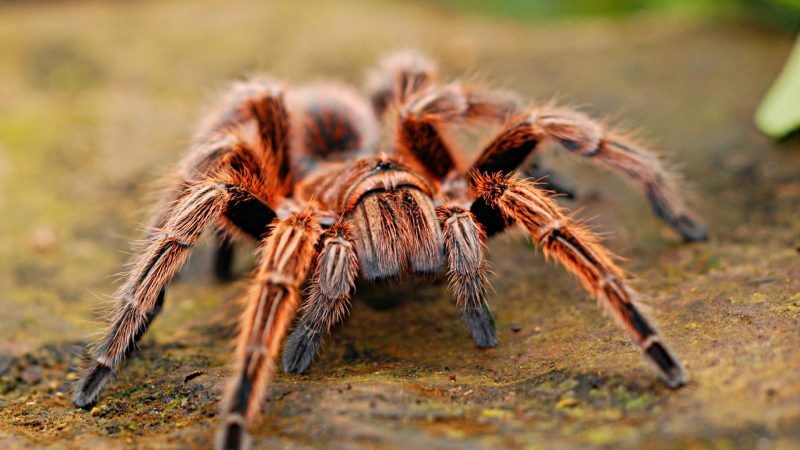
The spider anatomy incorporates many features shared with other arachnids, such as:
- Joint head and thorax (cephalothorax or prosoma)
- Bodies that divided into two sections
- Eight jointed legs
- No wings or antennae
- Chelicerae
- Pedipalps
- Black eyes
- Exoskeleton
Common Spiders of Missouri
Daddy-Long-Legs
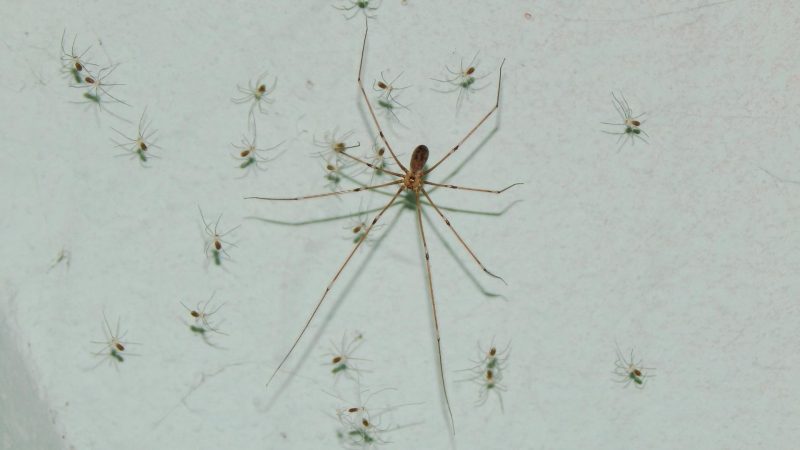
Daddy-Long-Legs (Leiobunum ventricosum) spiders are one of the most common Missouri spiders that are easily recognized. They possess overly long, thin legs and compact bodies.
Opposed to the popular myth, the daddy-long-leg spiders, commonly known as harvestmen, have no fangs or venom. They can’t also produce their own silk.
Unlike true spiders, the harvestmen possess only one body segment rather than two—the cephalothorax and abdomen. Furthermore, the daddy longlegs spiders are omnivorous and feed on rotting organic matter or small insects.
You can hold these spiders in your hand as they’re totally harmless.
- Appearance: Daddy longlegs spiders have spherical body shape with a length ranging from 0.6mm to 23 mm or 0.02 to 0.9 inch. Their legs are generally several times as long as their bodies and typically have cream to gray or brown color.
- Size: 0.6mm to 23 mm or equal to 0.02 to 0.9 inch
- Color: Cream, gray, and brown
- Lifespan: 1 year for male, 3 years for female
- Habitat: These spiders typically hang out in water sources, such as water fountains, ponds, puddles, and other water features. They can also be found indoors—behind doors, in the corner of the ceilings, under furniture, in garages, bin sheds, under decks, kitchens, and in other humid areas.
- Diet: Spiders, aphids, dead insects, mushrooms, bird droppings, and rotting fruit.
- Threat: None
Related: Are Daddy Longlegs Dangerous? | Information and Facts
How to Get Rid of Daddy-Long-Legs?
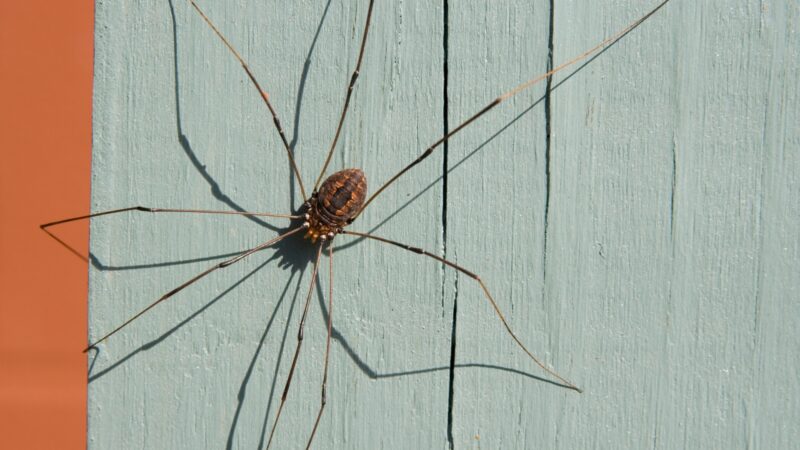
If you want to get rid of daddy longlegs from your home, here are some of the best ways to do it:
1. Use Spider Sticky Traps
Using sticky traps is one of the best ways to get rid of daddy longlegs spiders. Just make sure to place these traps strategically in areas where they can walk over them, like under your door frame.
That way, you can stop them from entering your room, making your space spider-free. You can purchase the spider's sticky traps online or in stores near you.
2. Use Boric Acid
Boric acid is a good alternative to chemicals and is one of the effective ways to keep spiders out of your home. All you have to do is sprinkle the boric acid powder around your crawl spaces, voids, under door frames, and around the edges of your areas.
When the harvestmen walk over it, it’ll damage their abdomen and will later kill it after ingestion. Although boric acid isn’t dangerous, it’s best to be cautious and use gloves and a mask when applying it.
Make sure to keep pets and kids away from it at all times. Furthermore, avoid applying this on food-prep areas which can be bought in stores near you or online .
3. Vacuum Up the Spiders
Using a vacuum in getting rid of daddy longlegs spiders is the easiest method to get rid of them. They can easily get sucked up by the vacuum since they’re not fast and are light as air.
4. Use DIY Repellent for Daddy-Long-Legs
Another way to get rid of the daddy longlegs spiders is by making a DIY repellent. To do this, get a clean spray bottle, add 1 cup white vinegar, and mix 1/2 cup vanilla extract.
Gently stir the mixture and spray it directly to areas, where they typically hang out. You can also spray it in the cracks and the edges of your home.
5. Use of Pesticides
Using pesticides is another way of getting rid of spiders. However, most pesticide products contain chemicals, so you should be careful in using them. Make sure to read the label for correct and safe use.
6. Call a Pest Control Expert
If none of the above procedures works, you can call a pest control expert to handle your spider problems. Since they have extensive knowledge about insects, they know very well the perfect method to use.
It’s also best to trim plants and clean up the trash and other debris around the area of your house. Moreover, repair cracks and crevices in your:
- Foundation
- Doors
- Windows
- Broken screens
Repairing the things mentioned above can prevent the daddy longlegs from entering your home.
Ambush Spiders
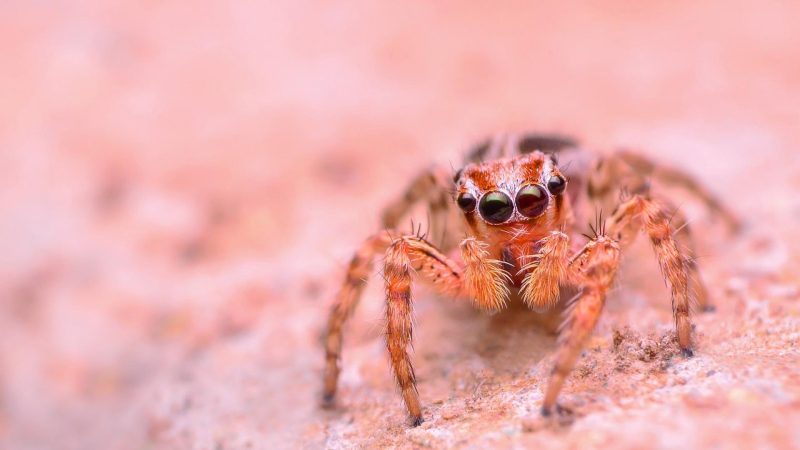
Ambush spiders are common spider species that ambush their prey, including wolf-spiders, jumping spiders, and Missouri tarantula.
These spiders usually have a black color and grow up to 1 inch or 2.54 cm. On top of that, they have a white patterned abdomen, resembling a face and green pedipalps. Furthermore, they can leap up to 50 times the length of their body.
Ambush spiders got their name through their action of being often seen creeping the ground looking for prey and ambushing them the least they expected. Their legs can reach up to 4 inches or more and are usually mistaken as tarantulas.
- Appearance: These spiders have different features, depending on their species. For example, adult jumping spiders usually have a black color with a white pattern on their abdomen.
- Size: 1 inch or exactly 2.54 cm
- Color: Black with a white pattern and brown
- Lifespan: 7 years or more for males and 30 years for females
- Habitat: These spiders live in well-drained, dry soils in open areas and can be found throughout grassland and desert areas. They’re commonly ground-dwellers, but some other species live in cliffs, trees, or caves.
- Diet: Cockroaches, crickets, king worms, mealworms, hornworms, silkworms, and more.
- Threat: None
Related: Jumping Spider Bites: Are Jumping Spider Bites Dangerous?
How to Get Rid of Ambush Spiders?
To get rid of these spiders, you can vacuum them and seal the cracks on your walls that serve as their entry points. You can also use pesticide spray and spray them directly on the ambush spiders.
Brown Recluse
The brown recluse or Loxosceles reclusa is a spider species commonly seen throughout Missouri. It possesses a marking on its carapace that’s violin-shaped.
This spider has received much negative publicity due to its necrotic venom that can rot the flesh. However, bites from the brown recluse spiders are rare. 90% of the bite from these spiders heal on their own while 10% are medically significant.
- Appearance: This spider species possess violin shape markings on their cephalothorax—a part of the spider’s body to which legs attach. They also have six pairs of eyes with a space splitting the pairs.
- Size: 1/4 of an inch to 1/2 of an inch in length
- Color: Tan to dark brown
- Lifespan: 1 to 2 years
- Habitat: Brown recluse spiders settle in dry, dark, and undisturbed areas. Indoors, can be found in basements, storage closets, cardboard boxes, laundry, and shoes. Outdoors, they can be found in garages, woodpiles, and sheds.
- Diet: Cockroaches, crickets, moths, and flies
- Threat: Contains necrotic venom
How to Get Rid of Brown Recluse Spiders?
If it’s an infestation, calling a pest control professional is your best solution. But, if the problem is still small, you can try the DIY approach.
However, before doing anything else, ensure to do an inspection first. You must wear long sleeves, boots, and gardening gloves to help protect your skin from the fangs of the brown recluse.
Natural Methods
Before starting, make sure to wear the listed things above and dust your home thoroughly. After that, vacuum your floor and put sticky traps in locations where these spiders typically hide, such as in basements, attics, garages, and closets.
Home Remedies
Another way you can get rid of brown recluse spiders is by making an equal solution of water and apple cider vinegar. Mix equal solutions in a clean spray bottle.
Moreover, you can also use a food-grade Diatomaceous Earth and sprinkle them on the surface. Once this product comes in contact with the brown recluse’s skin, it’ll cause dehydration that will eventually kill them slowly.
Insecticides
Using insecticides is the most dependable way to kill brown recluse spiders. There are ready-to-spray insecticides you can use to spray into the cracks and crevices of your walls or spray them directly to these spiders once spotted.
Make sure to read the label for proper and safe usage of these insecticide products to avoid putting your family at risk.
Related: How to Get Rid of Brown Recluse Spiders? | A Detailed Guide
Black Widow
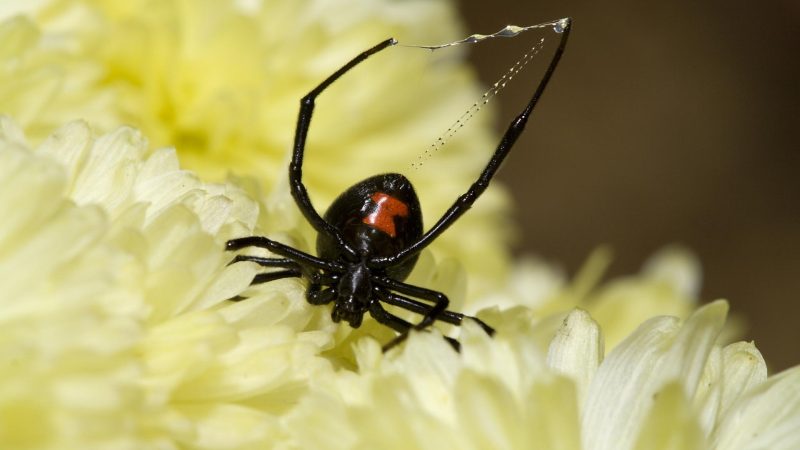
The black widow is regarded as North America’s most venomous spider. Female black widows can be identified with their large, black abdomen and red hourglass pattern underneath.
Their bites are extremely painful and will need medical attention. Nonetheless, no death has ever been reported due to its bite.
- Appearance: The female black widow has a shiny black body with reddish-to-yellow hourglass markings on the spherical abdomen’s underside.
- Size: 3 mm to 10 mm in length
- Color: Shiny black bodies
- Lifespan: 1 to 3 years
- Habitat: These spiders can be found in woodpiles, holes, stones, garages, and other dim-light areas.
- Diet: Mosquitoes, flies, grasshoppers, caterpillars, and beetles
- Threat: Venomous
How to Get Rid of Black Widow Spiders?
You can get rid of black widow spiders by using the following items in your surroundings:
Vinegar, Vacuum & Insecticides
Using vinegar is another way of getting rid of black widow spiders. The acidity of vinegar can burn the body of these spiders.
To use, mix equal parts of water and vinegar in a clean spray bottle and spray it directly on the black widows. Furthermore, you can also use a vacuum to get rid of these spiders.
If none of those mentioned above works, you can use insecticide spray or call a professional pest control provider.
Wolf Spiders
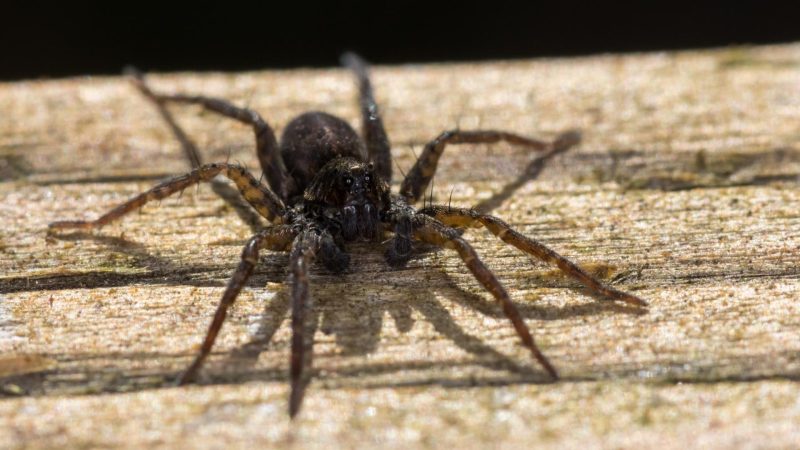
Wolf spiders are one of the members of the family Lycosidae that are feared due to their big size. Nonetheless, they’re mostly harmless to humans but will bite once provoked.
Their bites can tear the skin and cause redness, pain, and swelling.
- Appearance: The wolf spiders are typically grey, brown, black, or tan, with dark markings. Their coloring is an effective camouflage, allowing them to catch their prey and keep them away from predators.
- Size: 3 mm in length
- Color: Grey, brown, black, or tan, with dark markings.
- Lifespan: 1 year
- Habitat: Grey, brown, black, or tan, with dark markings
- Diet: Crickets, ants, grasshoppers, other spiders, and small invertebrates
- Threat: Their bites can cause allergic reactions but are not poisonous.
Related: Are Wolf Spiders Poisonous? | Important Facts!
How to Get Rid of Wolf Spiders?
To get rid of wolf spiders, clear all the clutter around your home, as well as the mulch. Then, use an insecticide spray and spray it directly on wolf spiders. Furthermore, it’s best to seal all the cracks to ensure that no spiders can enter your home.
Orbweaver Spiders
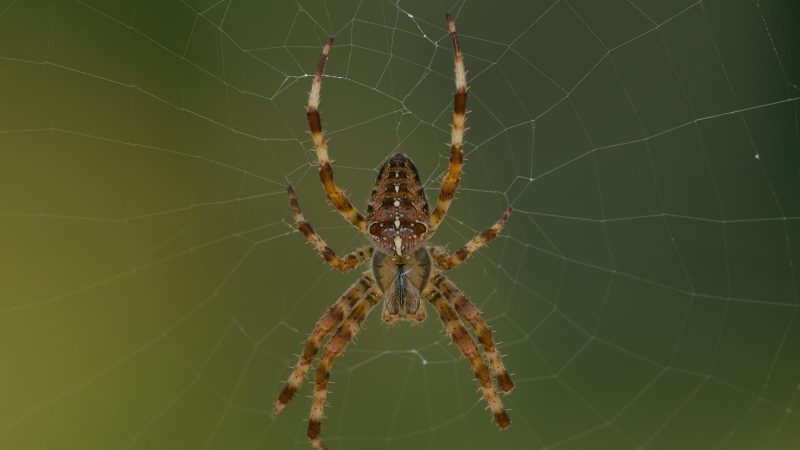
The orb weaver spiders are one of the members of the family Araneidae. They appear formidable with their bright yellow markings.
Moreover, they’re highly venomous spiders in the wild. However, they don’t possess potent venom to harm people or pets.
- Appearance: Most orb weavers are hairy, bright-colored, and have a large abdomen overlapping the cephalothorax’s back edge. Furthermore, they’re stout and possess a grey to reddish-brown color. They also have triangular abdomens and two prominent humps in the front.
- Size: 6mm
- Color: Grey to reddish-brown
- Lifespan: 1 year
- Habitat: These spiders typically live in fields, gardens, and forests.
- Diet: Moths, flies, beetles, mosquitoes, and wasps
- Threat: They bite, but their venom isn’t toxic enough to be life-threatening.
How to Get Rid of Orbweaver Spiders?
Orbweaver spiders are great at eating mosquitoes and flies. However, they like to dwell in bushes and create unsightly webs. To get rid of these spiders, trim your bushes and remove dead branches, leaves, and other garden waste that has been accumulated.
By reducing their hiding spots, they’ll eventually get away from your gardens as they won’t have any protection against the heat of the sun. A spider spray can also come in handy for a small amount of orb weaver spiders.
In case of a large infestation, call a pest control expert right away.
Texas Brown Tarantula
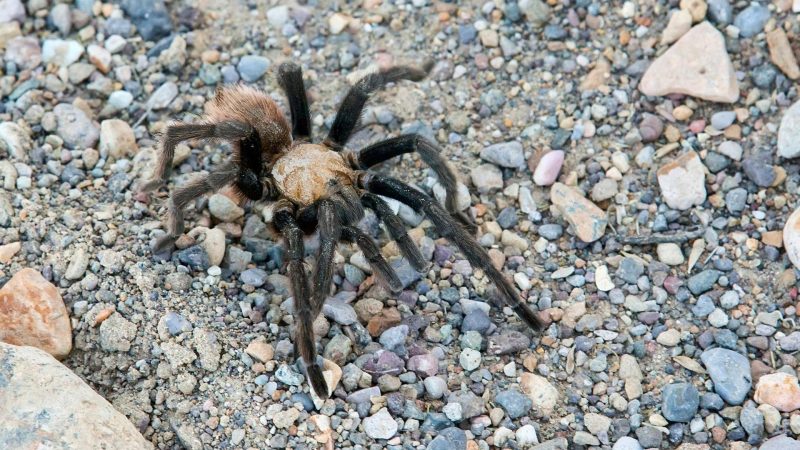
The Texas brown tarantula is one of the most common tarantula species in the United States. They can grow up to 4 inches in length and weigh around 3 oz or more as adults. Moreover, they’re species and among the largest spider species in Missouri.
- Appearance: This tarantula species is hairy and stocky. The legs and body are lighter brown, having reddish hairs on the carapace. Moreover, the legs of the Texas brown tarantula possess light-colored hairs close to their feet.
- Size: 4 inches in length, 3 oz in weight (adult)
- Color: Chocolate brown
- Lifespan: 10 years for males, over 30 years for females
- Habitat: They’re mostly found in stones, grasslands, farmlands, burrowed underground, etc.
- Diet: Crickets, grasshoppers, and other small invertebrates
- Threat: They bite but don’t cause any serious danger except when someone is allergic to their bites.
How to Get Rid of Texas Brown Tarantula?
To get rid of the Texas brown tarantula, you have to declutter and organize the things in your place. After that, use pyramid aerosol to get rid of these tough-looking tarantulas.
All you have to do is spray it directly on the tarantula, and it’ll quickly knock them down.
List of Sources
Daddy Long Legs. UC Riverside – Spider Research.
Potter, M. F (2018). Brown Recluse Spider. University of Kentucky.
Jacobs, S. (2018). Bold Jumper Spider. PennState Extension.
- How to Get Rid of Copperheads | Practical Guide - August 27, 2023
- How to Get Rid of Corn Snakes | What Makes Them Aggressive? - August 27, 2023
- How to Get Rid of Alligators | Safety Measures and Removal Methods - July 16, 2023
